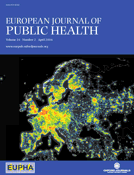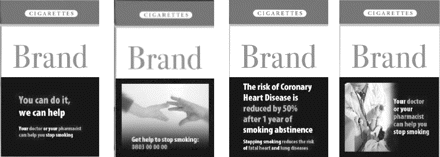-
PDF
- Split View
-
Views
-
Cite
Cite
David Hammond, Geoffrey T. Fong, Paul W. Mcdonald, K. Stephen Brown, Roy Cameron, Showing leads to doing: graphic cigarette warning labels are an effective public health policy, European Journal of Public Health, Volume 16, Issue 2, April 2006, Pages 223–224, https://doi.org/10.1093/eurpub/ckl037
Close - Share Icon Share
Sir
Ruiter and Kok1 criticize a study we published in the American Journal of Public Health, which found that smokers who experienced greater emotional reactions in response to graphic cigarette warning labels in Canada were more likely to engage in cessation behaviour at follow-up.2 Ruiter and Kok conclude that: ‘Policy makers should…be reluctant to introduce cigarette warning labels and should instead focus on more effective interventions and policies.’ We strongly disagree. We believe that graphic labels are a vital component of a comprehensive approach to tobacco control.
Ruiter and Kok raise a number of concerns about our study. First, they question the validity of self-report measures. Bias in self-report related to smoking is a concern among populations where social desirability bias is strong (notably among underage youth and pregnant women). However, biochemical validation of self-reported measures indicates that the accuracy of self-report is generally high, particularly within observational studies, interviewer-administered surveys, and among adults-all features of our study.3 In addition, we used the same questions and mode of survey (random-digit dial telephone methodology) as the ‘gold standard’ national surveys of adult smoking behaviour in the United States and Canada.4 Perhaps most important, even if our sample was over-reporting intentions to quit or abstinence at follow-up, this is a systematic bias that would apply across the sample. In order to change the nature of our findings, this bias would need to be associated with reporting greater emotional reactions to the warnings, after adjusting for a host of socio-demographic variables and measures of smoking behaviour. We find this to be an implausible account of the findings.
Second, Ruiter and Kok note that ‘Without an experimental design, there is no evidence that warning labels are responsible for these outcomes.’ While experimental designs have the potential to enhance internal validity, they have serious limitations in external validity. Given that package warning labels are introduced at the national level, and that countries cannot be randomized to different conditions, it is simply not possible to conduct experimental research on the implementation of pictorial warnings. The most rigorous alternative would be a quasi-experimental research design that includes pre- and post-evaluations, across several countries that can serve as comparison groups. Such designs are high in both internal and external validity. In fact, we are investigators on such a study—the International Tobacco Control Policy Evaluation (ITC) Survey—that is being conducted with a cohort of more than 8000 adult smokers from Canada, the United States, Australia, and the United Kingdom. The quasi-experimental evidence on the effectiveness of the Canadian warnings from the ITC survey is entirely consistent with the results published in the AJPH article.5
Ruiter and Kok's primary criticism of graphic warnings appears to be that they ignore the evidence on fear-appeals. The most consistent finding from this literature is that fear appeals are effective when paired with strong efficacy messages for a specific outcome (i.e. quitting smoking). A recent meta-analysis of the literature on public health communications concluded that ‘strong fear appeals and high-efficacy messages produce the greatest behavior change’, and found no evidence of any iatrogenic or ‘boomerang’ effects for strong fear appeals.6 The Canadian warnings are entirely consistent with this literature: in addition to information on the health risks, they include messages designed to increase self-efficacy for quitting. These messages include both general messages of support, as well as concrete information on ways to quit smoking and specific sources of help, including a website address. The next generation of Canadian warnings will also include a toll-free telephone quit-line number. Quit-line information already appears on packs in several countries, including Holland, where calls to the quit-line increased dramatically after appearing on packages.7 The pictorial warnings that have been proposed by the European Union (EU) include even stronger efficacy information on the outside of packs, as well as a toll-free quit-line number (figure 1). Overall, the pictorial warnings in Canada and those proposed in the EU incorporate many of the recommendations from the literature cited by Ruiter and Kok, as well as from the field of psychology more generally.8
Examples of cigarette warning labels proposed in the European Union
Ruiter and Kok also draw attention to the lack of published data on graphic warning labels. Although this is a new research field—2001 marked the first year pictorial warnings ever appeared on cigarette packages—numerous scientific reports on graphic warnings have been published.5,9–12 Substantial research has also been conducted by the Government of Canada, some of which is cited in our published work and the rest of which is publicly available.13 All evidence suggests that graphic warnings are (i) a prominent source of health information, second only to television in many jurisdictions; (ii) more likely to be noticed and discussed than text warnings; (iii) associated with greater health knowledge; (iv) associated with increased cessation behaviour; and (v) enjoy high credibility and support from smokers themselves. Pictorial warnings may be particularly important in reaching low-income or low-literacy individuals who may not have access to other mediums of health information. Overall, we are unaware of a single empirical study which suggests that graphic pictorial warnings are ineffective or, worse, counter-productive. Perhaps this explains why tobacco companies have opposed comprehensive cigarette warnings so vigorously.14
We would also argue that policy-makers have a strong moral obligation to inform consumers about the risks of smoking. Tobacco use kills ∼650 000 Europeans each year, more than illicit drug use, AIDS, alcohol, and homicide combined.15 The primary intent of pictorial warnings is not to scare, but to inform smokers about the full range, likelihood, and severity of smoking-related disease. As we note in the AJPH article, the health risks of smoking are inherently frightening: warnings of lung cancer that fail to contain arousing information also fail to communicate these risks in a truthful, forthright manner. In addition, as figure 1 indicates, not all pictorial warnings contain frightening information.
In short, the evidence indicates that smokers in the EU and elsewhere would benefit from pictorial warnings, and there is little or no evidence to cause reluctance among regulators. Best of all, pictorial warnings are free to governments and, to the extent that they have any impact at all, are among the most cost-effective public health interventions available.
References
Ruiter RAC, Kok G. Saying is not (always) doing: cigarette warning labels are useless.
Hammond D, Fong GT, McDonald PW, et al. Graphic cigarette package warning labels do not lead to adverse outcomes: evidence from Canadian smokers.
Patrick DL, Cheadle A, Thompson DC, et al. The validity of self-reported smoking: a review and meta-analysis.
Health Canada. Canadian tobacco use monitoring survey (CTUMS). Tobacco Control Program. Ottawa, Ontario: Health Canada. Available at: http://www.hc-sc.gc.ca/hecs-sesc/tobacco/research/ctums/index.html.
Fong GT, Hammond D, Borland R, et al Quasi-experimental evaluation of the enhancement of warning labels in the United Kingdom: initial findings from the International Tobacco Control Policy Evaluation Survey. Scottsdale, Arizona: Society for Research on Nicotine and Tobacco Conference,
Witte K, Allen M. A meta-analysis of fear appeals: implications for effective public health campaigns.
Willemsen MC, Simons C, Zeeman. G. Impact of the new EU health warnings on the Dutch quit line.
Strahan EJ, Fabrigar LR, Fong GT, et al. Enhancing the effectiveness of message labels on tobacco packaging: a social psychological perspective.
Hammond D, Fong GT, McDonald PW, et al. The impact of the graphic Canadian warning labels on adult smoking.
Fong GT, Cameron AJR, Brown KS, et al. Effects of the Canadian graphic warning labels among high school students: a quasi-experimental longitudinal survey. Paper presented at the 2002 National Conference on Tobacco or Health, San Francisco, California.
Hammond D, McDonald PW, Fong GT, Cameron AR. Cigarette warning labels, smoking bans, and motivation to quit smoking: evidence from former smokers.
Hammond D, Fong GT, Borland R, et al. Health knowledge and tobacco labelling policy: findings from the International Tobacco Control Evaluation Survey.
Health Canada. Tobacco-Reports and Publications. Available at: http://www.hc-sc.gc.ca/hl-vs/pubs/tobac-tabac/index_e.html. Accessed 13 March 2006.
Chapman S, Carter SM. ‘Avoid health warnings on all tobacco products for just as long as we can’: a history of Australian tobacco industry efforts to avoid, delay and dilute health warnings on cigarettes.
Tobacco or health in the European Union: Past, Present and Future. The ASPECT Consortium. European Commission.





Comments